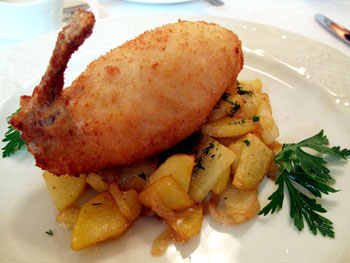 I was recently in St Petersburg Russia and had a great lunch at Tsar Restaurant (note: avoid bottled water, each one cost $25). I decided to try the Chicken Kiev, which was pretty common on the restaurant menus in St. Petersburg, and it seemed so “Russian” (though I later discovered that it’s not).
I was recently in St Petersburg Russia and had a great lunch at Tsar Restaurant (note: avoid bottled water, each one cost $25). I decided to try the Chicken Kiev, which was pretty common on the restaurant menus in St. Petersburg, and it seemed so “Russian” (though I later discovered that it’s not).
Chicken Kiev is actually French in origin. Russian aristocracy became very interested in French cuisine in the 1700s and they would send their Russian chefs to France to train or bring French chefs into Russia.
A French chef called Nicolas Francois Appert invented Chicken Kiev in the early 1800s. Appert's invention became famous and Russian chefs tried to imitate Chicken Kiev, calling the dish "cotelettes de volaille" instead of Chicken Kiev.
Early restaurants in New York City changed the name back to Chicken Kiev, in an attempt to attract the new Russian immigrants and this name stuck. Traditionally, it is deep fried in oil, but I found a recipe from America’s Test Kitchen that achieves the same crisp coating with frying.
Herb Butter:
8 tablespoons unsalted butter (1 stick), softened
1 tablespoon minced shallot
1 tablespoon minced fresh parsley leaves
1 teaspoon minced fresh tarragon leaves
1 tablespoon fresh lemon juice
3/8 teaspoon table salt
1/8 teaspoon ground black pepper
Chicken:
4 – 5 slices white sandwich bread, cut into 3/4-inch cubes
2 tablespoons vegetable oil
4 boneless, skinless chicken breasts (7 to 8 ounces each), tenderloins removed
1 cup all-purpose flour
3 large eggs, beaten
1 teaspoon Dijon mustard
INSTRUCTIONS:
For the Herb Butter: Mix butter, shallot, herbs, lemon juice, salt, and pepper in medium bowl with rubber spatula until thoroughly combined. Form into 3-inch square on plastic wrap; wrap tightly and refrigerate until firm, about 1 hour.
For the Chicken: Adjust oven rack to lower-middle position; heat oven to 300 degrees. Add half of bread cubes to food processor and pulse until cubes are coarsely ground, about sixteen 1-second pulses. Transfer crumbs to large bowl and repeat with remaining bread cubes (you should have about 3 1/2 cups crumbs). Add 1/8 teaspoon salt and 1/8 teaspoon pepper to bread crumbs. Add oil and toss until crumbs are evenly coated. Spread crumbs on rimmed baking sheet and bake until golden brown and dry, about 25 minutes, stirring twice during baking time. Let cool to room temperature (you should have about 2 1/2 cups bread crumbs).
Prepare cutlets: Starting on thinnest side, butterfly breast by slicing lengthwise almost in half. Open breast up to create a single, flat cutlet. With cutlet between sheets of plastic wrap, pound (starting at center) to 1/4-inch thickness. Pound the outer perimeter to 1/8 inch.
Unwrap butter and cut into 4 rectangular pieces. Place chicken breast cut side up on work surface; season both sides with salt and pepper. Place 1 piece of butter in center of bottom half of breast. Roll bottom edge of chicken over butter, then fold in sides and continue rolling to form neat, tight package, pressing on seam to seal. Repeat with remaining butter and chicken. Refrigerate chicken, uncovered, to allow edges to seal, about 1 hour.
Adjust oven rack to middle position and heat oven to 350 degrees. Place flour, eggs, and bread crumbs in separate pie plates or shallow dishes. Season flour with 1/4 teaspoon salt and 1/8 teaspoon pepper; season bread crumbs with 1/2 teaspoon salt and 1/4 teaspoon pepper. Add mustard to eggs and whisk to combine. Dredge 1 chicken breast in flour, shaking off excess, then coat with egg mixture, allowing excess to drip off. Coat all sides of chicken breast with bread crumbs, pressing gently so that crumbs adhere. Place on wire rack set over rimmed baking sheet. Repeat flouring and breading of remaining chicken breasts.
Bake until instant-read thermometer inserted into center of chicken (from top) registers 160 degrees, 40 to 45 minutes. Let rest 5 minutes on wire rack before serving.
James Moore is a producer, publicist and freelance writer. When not traveling the world, he's home in Los Angeles, testing and photographing food to post on his blog Cook Like James

